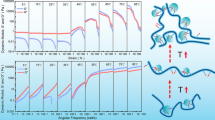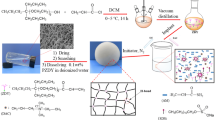Abstract
Hydrophobic associating polymer was synthesized by aqueous polymerization of acrylamide, 2-acrylamide-2-methylpropanesulfonic acid and hydrophobic monomer octadecyl dimethyl allyl ammonium chloride (C18DMAAC) by aqueous phase polymerization with potassium persulfate sodium bisulfite oxidation–reduction initiation. The structure of the polymer was characterized by FTIR and TGA, the effect of hydrophobic monomer on the properties of polymer powder in deionized water and salt was investigated. The salt resistance, temperature resistance and shear resistance of the diluent were studied by Brinell viscometer and rheometer when the copolymer was diluted to 1500 ppm in deionized water. The results showed that the solubility of the polymer decreased with the addition of C18DMAAC, the salt resistance and temperature resistance increased significantly. The total salinity of the copolymer was 25,000 mg/L at 68 ℃, and the viscosity under 1500 mg/L calcium and magnesium ions was more than 20 mPa s. After 120 min shearing, the viscosity of the polymer solution with hydrophobic monomer is more than 900 mPa s, and the viscosity retention rate is more than 90%.









Similar content being viewed by others
References
Wu SY, Xia PH, Li YB et al (2017) Preparation and performance analysis of hydrophobic associating polymer for oil displacemen. Contemp Chem Ind 46(5):821–823
Song CL, Yang QB, An HY, Zhang WD, Wang PX (2010) Development of hydrophobically associating water-soluble polymer. Appl Chem Ind 39(5):735–746
Evani S, Rose GD (1987) Water soluble hydrophobe association polymers. Polym Mater Sci Eng 57:477–481
Hiroshi Y, Itsuro T, Akihito H (2000) Associative properties in water of copolymers of sodium 2-(acrylamido)-2-methylpropanesulfonate and methacrylamides substituted with alkyl groups of varying lengths. Macromolecules 33(21):7852–7861
Li J, Zhang L, Zhao S, Yang Y, Cao X, Zhang J (2014) Interfacial shehangar rheological properties of enhanced oil recovery polymers with different structures. Chin J Chem 35(4):791–797
Constantinos T, Ilias I, Guylaine D (2000) An associative polyelectrolyte end-capped with short polystyrene chains. Synth Rheol Behav Macromol 33(8):2936–2943
Liu M, Gou S, Wu Q, Yang X, He Y, Zhou L et al (2019) Ionic liquids as an effective additive for improving the solubility and rheological properties of hydrophobic associating polymers. J Mol Liq 296:111833
Afolabi RO, Oluyemi GF, Officer S, Ugwu JO (2019) Hydrophobically associating polymers for enhanced oil recovery–part B: a review of modelling approach to flow in porous media. J Mol Liq 293:111495
Wang C, Yang T, Wang T, Qiu L (2018) Thermosensitive behavior of hydrophobically associating anionic guar gum solutions and gels. Int J Biol Macromol 111:169–177
Xu J, Zhao WJ, Chen XJ, Yao K, Yan YB (2018) Introduction of an extra tryptophan fluorophore by cataract-associating mutations destabilizes βB2-crystallin and promotes aggregation. Biochem Biophys Res Commun 504(4):851–856
Mao J, Tan H, Yang B, Zhang W, Yang X, Zhang Y, Zhang H (2018) Novel hydrophobic associating polymer with good salt tolerance. Polymers 10(8):849
Valint Jr. PL, Bock J (1988) Synthesis and characterization of hydrophobically associating block polymers. Macromolecules 21(1):175–179
Zhang Y, Mao J, Zhao J, Yang X, Zhang Z, Yang B, Zhang H et al (2018) Preparation of a novel ultra-high temperature low-damage fracturing fluid system using dynamic crosslinking strategy. Chem Eng J 354:913–921
Cui Q, Zhang J, Xue T (2016) Study on synthesis and application performance of hydrophobic associated polymer drag reducing agent. J Residuals Sci Technol 13(6):1–10
Author information
Authors and Affiliations
Corresponding authors
Additional information
Publisher's Note
Springer Nature remains neutral with regard to jurisdictional claims in published maps and institutional affiliations.
Rights and permissions
About this article
Cite this article
Shi, J., Wu, Z., Deng, Q. et al. Synthesis of hydrophobically associating polymer: temperature resistance and salt tolerance properties. Polym. Bull. 79, 4581–4591 (2022). https://doi.org/10.1007/s00289-021-03713-x
Received:
Revised:
Accepted:
Published:
Issue Date:
DOI: https://doi.org/10.1007/s00289-021-03713-x




